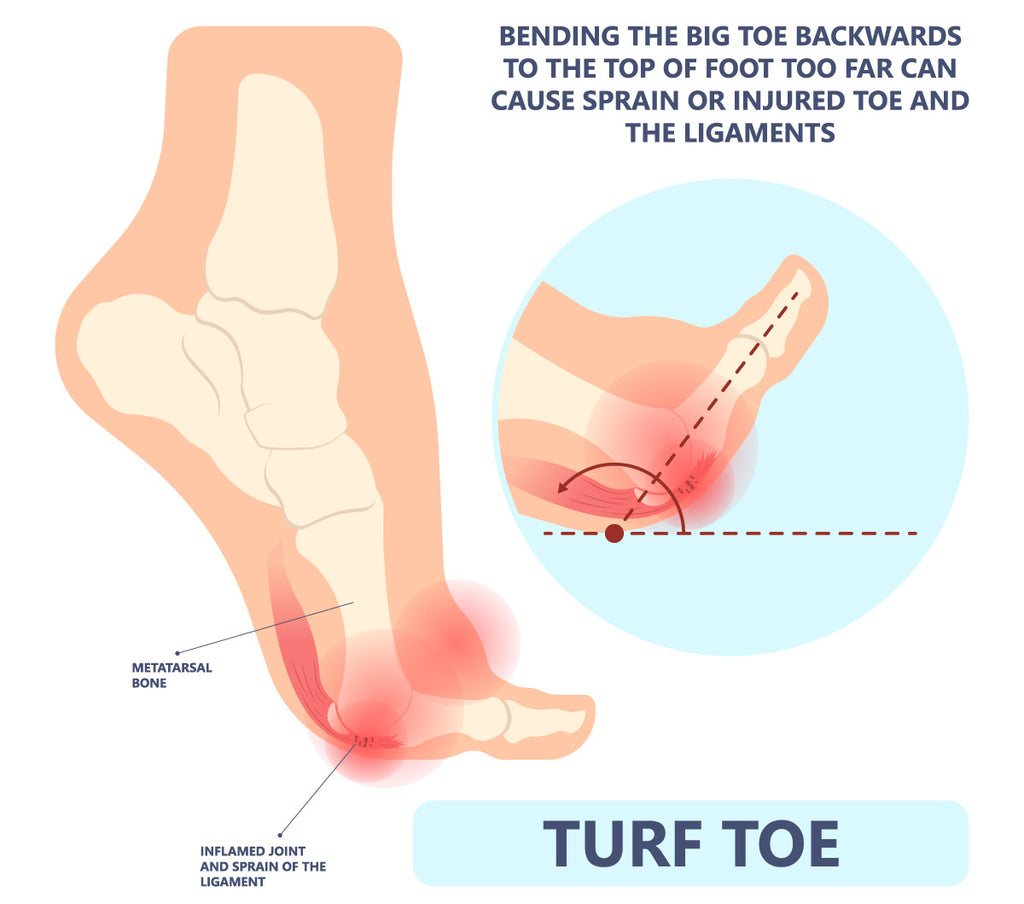Turf Toe is a term used to describe a sprain of the big toe's joint capsule and ligaments or other soft tissue, typically resulting from hyperextension of the big toe too far or too forcefully. It’s a metatarsophalangeal joint sprain, an injury to the connective tissue between the foot and a toe. When the big toe is involved, it is known as "turf toe”.
How do you get Turf Toe?
It often occurs in athletes who play sports on artificial turf surfaces, which can be quite firm, leading to increased stress on the toe joint. However, it can happen in various activities and not exclusively on turf. It can result from playing sports on any rigid surface. It is a fairly common injury among professional football, soccer, baseball, basketball, rugby, volleyball, and tae kwon do athletes. Adding to the problem is athletic shoes with very flexible soles combined with cleats that "grab" the turf causing overextension of the big toe. This is a primary reason why many athletes prefer natural grass to turf, because it is softer. The condition can also result from repetitive stress on the toe joint occurring over time, as seen in activities that involve a lot of running, jumping, or quick changes of direction.
What are the symptoms of turf toe?
The symptoms of Turf Toe can range from mild to severe and may include:
- Pain is the most common symptom, usually at the base of the big toe.
- Swelling around the injured joint is often present.
- The toe may feel stiff and movement can be limited due to pain.
- Tenderness: Tenderness and sensitivity to touch over the affected area.
- In more severe cases, bruising may occur.

What treatments are available for turf toe?
Treatment for Turf Toe depends on the severity of the injury. Common approaches include:
- Giving the toe time to heal by avoiding activities that put stress on the joint.
- Immobilization with taping, splinting, or wearing a stiff-soled shoe can help protect the toe and promote healing.
- Applying ice to the area can help reduce swelling and alleviate pain.
- Nonsteroidal anti-inflammatory drugs (NSAIDs) may be used to manage pain and inflammation.
- Gentle exercises and stretches can help maintain range of motion and prevent stiffness.
- Wearing shoes with a stiff sole or inserts that limit movement of the toe joint can aid in healing.
- Depending on the severity, a walking boot or cast might be used to restrict movement and protect the toe while it heals.
- As the toe heals, gradually reintroducing activities and sports is important to prevent re-injury.
Does turf toe go away?
The outcome of Turf Toe depends on the severity of the injury and how well it is managed. Mild cases can often be effectively treated with conservative measures, and the individual can expect a full recovery within a few weeks. More severe cases might take longer to heal and could require more intensive treatment, including extended rest and therapy.
Can you prevent turf toe?
As they say, an ounce of prevention is worth a pound of cure. Preventing turf toe involves taking steps to reduce the risk of hyperextending the big toe joint during activities before an injury can occur. Here are some strategies you can consider:
- Consider wearing protective gear, such as shoes with a reinforced toe box, to help prevent excessive bending of the big toe.
- If you're increasing the intensity or frequency of physical activities, do so gradually. Sudden spikes in activity can increase the risk of injuries like turf toe.
- Prior to engaging in sports or activities, perform a proper warm-up routine that includes dynamic stretching for your lower limbs. This can help prepare the muscles and joints for movement.
- Incorporate exercises that focus on strengthening the muscles around the toe joint and the foot. This can provide better support and stability to the joint.
- Pay attention to your running or movement mechanics. Ensure you're using proper technique to reduce the risk of putting excessive stress on the toe joint.
- If possible, choose sports venues with grass or natural turf, which are generally softer than artificial turf and might reduce the impact on the toe joint.
- Make sure your shoes fit properly and provide enough space for your toes. Shoes that are too tight can increase pressure on the big toe joint.
- If you have a history of turf toe or are prone to it, consider using orthotic inserts or devices recommended by a medical professional to provide extra support to the foot.
- Be mindful of your movements during sports and activities. Avoid hyperextending the big toe when pushing off or changing direction.
- After physical activity, engage in a cool-down routine that includes static stretching to maintain flexibility and reduce the risk of muscle imbalances.
- Pay attention to any discomfort or pain in the toe or foot. If you notice any symptoms, it's important to address them promptly and take appropriate measures to prevent further injury.
- Wear shoes that provide adequate support and cushioning for your activities. Look for shoes with a stiff sole that limits the range of motion of the big toe joint.
Remember that every individual's body and needs are unique. If you have concerns about preventing turf toe or any other sports-related injuries, it's a good idea to consult with a medical professional or a sports medicine specialist. They can provide personalized advice based on your specific situation and activity level.
How bad can turf toe get?
It's important to note that if Turf Toe is not properly managed and rehabilitated, it could lead to chronic pain, instability, or even the development of osteoarthritis in the affected joint. Seeking prompt medical attention and following the recommended treatment plan can significantly improve the chances of a positive outcome and a return to normal activities.





























